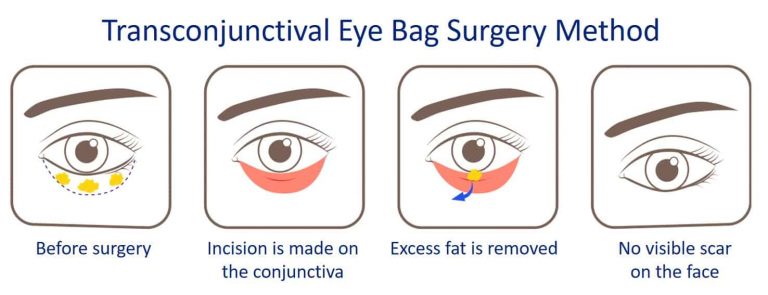
Eye Bag Removal Surgery & Fat Repositioning

Procedure Time
1 – 2 Hours

Anaesthesia
Sedation

Recovery Period
10 – 14 Days

Stitch Removal
7 Days Post-op
What Is Eye Bag Removal Surgery (Lower Blepharoplasty)?
Eye bag removal surgery, also known as lower blepharoplasty, is a cosmetic procedure designed to reduce the appearance of bags and puffiness under the eyes. This surgery involves the removal or repositioning of excess skin, fat, and muscle from the lower eyelids to create a smoother and more youthful appearance. It is commonly sought by individuals experiencing sagging skin and bulging fat due to aging or genetic factors. The procedure can significantly enhance facial aesthetics by providing a refreshed look, often boosting self-confidence and improving one’s overall appearance.
Individuals with milder eye bags can consider non-surgical eye bag removal treatments.
Eye Bag Removal Options in Singapore
Dream offers two specialised surgical options for eye bag removal: Transconjunctival Lower Blepharoplasty and Incisional Lower Blepharoplasty techniques. The transconjunctival method, ideal for younger patients with minimal bulging, involves an internal incision for a scar-free outcome.
In contrast, the incisional technique targets more prominent eye bags and excess skin, with an external incision along the lash line for comprehensive reshaping. Our team will work with you to identify the approach that best aligns with your goals and lifestyle.
Surgical Eye Bag Removal (Blepharoplasty)
Transconjunctival Lower Blepharoplasty Technique

This procedure involves a small incision inside the lower eyelid. In this method, the surgeon uses an electrocautery to make the cut and remove the fat. This technique is more popular because it leaves no visible scars on the outside of the eye.
Benefits
- No visible scars
- Better preservation of the natural eye shape
- Quick recovery times
- Reduced swelling and bruising
- Less trauma
Suitable Candidates
This technique is the best choice for individuals who are young and have good skin elasticity. The procedure provides best results to individuals with mild to moderate eye puffiness and less skin under the eyes.
Incisional Lower Blepharoplasty Technique
This procedure uses an incision along the lower eyelid crease to remove excess fat and skin. It produces a skin tightening effect as well as lightens dark circles. The procedure takes about one and a half to two hours and is associated with a recovery time of 10 to 14 days.
Incisional Eye Bag Surgery Method
Benefits
- Removal of excess skin and the fat causing the bulge
- More effective skin tightening results, helping to achieve a smoother under-eye contour
- Addresses tear through depression issues more effectively
- Effective treatment of eye bag conditions of more serious nature
Suitable Candidates
Incisional eye bag removal is shown to produce best results for individuals with moderate puffiness, excessive skin under the eyes, and dark circles which need skin tightening to remove them.
What Is Under Eye Fat Repositioning Surgery?
Under eye fat repositioning or eye bag surgery (lower blepharoplasty) with fat repositioning is a surgical procedure that is used for removing eye bags and correct sagging skin under the eyes. The procedure also fills up the sunken area and improve wrinkles under the eyes that are formed due to fat removal, resulting in a younger and brighter look. Excess fat is removed and repositioned in this process to correct that groove under the eyebag. During the procedure, the eyebag gets flattened and it corrects any outward bulge. The procedure also involves removal of any excess skin while tightening the lower eyelid upwards for creating a smooth and taut contour.
How to Choose Between Surgical and Non-Surgical Eye Bag Removal
Choosing between surgical and non-surgical eye bag removal depends on factors such as recovery time, anatomy, and personal preferences. Surgical options typically yield more permanent results and are ideal for those with prominent under-eye bags caused by fat deposits. However, they require a longer recovery period.
Non-surgical treatments, on the other hand, offer a less invasive solution with minimal downtime, suitable for individuals with milder puffiness or those looking for temporary enhancements. At Dream Aesthetics & Plastic Surgery, we guide you through each option, helping you make an informed decision based on your needs, ensuring that the treatment you choose aligns with your aesthetic goals.
Surgery procedure steps
Removing any excessive skin and redistributing and repositioning fat helps in rejuvenating the face while lending a more youthful look. Here are the steps that the surgeon will follow while performing under eye fat repositioning surgery.

Recovery From Eye Bag Removal Surgery
For quick and seamless recovery, it is very important to follow the post-surgical instructions advised by the surgeon. Apply cold compresses regularly for around 48 hours to reduce discomfort and swelling. Use eye drops and prescription ointments as advised to prevent infection and promote healthy healing.
Some swelling and bruising should be expected in the days following the surgery. When going outdoors, patients should use dark-tinted sunglasses to protect their eyes and the healing skin. Strenuous physical workouts should be avoided completely for the first two to three weeks after surgery.
In most cases, patients experience a significant decrease in bruising and swelling during the initial 10-14 days after their eye bag removal surgery. After that, the patients should be able to resume their regular activities. If patients experience any pain or unusual symptoms after the surgery, it is advisable to consult a doctor immediately.
What Is The Cost Of Eye Bag Surgery in Singapore?
The cost of eye bag plastic surgery varies by technique, the experience of the surgeons, operating facilities, anesthesia, and some other factors. However, the average eye bag surgery cost in Singapore is between $4,500 to $7,500.
Planning to get eye bag removal surgery (lower blepharoplasty) at Dream Singapore and wanting to know eye bag removal Singapore cost, and you have questions in mind? Contact our medical team for more information about eye bag removal price in Singapore.
Contact us at +65 6871 8888 or send us a message through our enquiry form to get in touch. We will guide you through every step of the process.
Frequently Asked Questions (FAQ) about Eye Bag Removal Surgery
How to prepare for Eye Bag Removal Surgery?
You should schedule your procedure when you are ready for it. But before undergoing the surgery, you need to take some preoperative measures. Your doctor will tell you about these instructions beforehand.
Some preparing measures for eye bag surgery include:
- Basic instructions before surgery like what you should eat or drink a day before surgery.
- Eye drops or other medications, you need to take before surgery
- A caregiver to bring you home after surgery
- Have these items with you
- Cloths and ice packs for cold compresses
- Sunglasses to protect your eyes
How Can I Get Rid Of The Dark Circles Underneath My Eyes?
Dark circles are the result of different types of conditions including:
- fat pad in the lower eyelid
- bulging of the lower eyelid
- hyperpigmentation in the eyelid skin (brown pigment)
As there are different causes for dark circles, the treatment methods are also different. In cases of hyperpigmentation, non-invasive laser treatments can help to lighten the discolouration.
On the other hand, if it is due to a fat pad or bulging of the lower eyelid then eye bag surgery treatment will be more suitable.
Can A History Of Bad Scars Interfere With My Surgical Outcomes?
Skin on the facial area and body area is slightly different and so is its healing.
Previously pierced skin (pierced ears) can give you an idea of how your body will respond to the eye bag removal surgery. The facial region is a sensitive area. The good thing is that it is replete with numerous blood vessels so healing is better as compared to other parts of the body.
You should show any previous scars (such as keloid scars) to the doctor at the time of consultation. The plastic surgeon will then provide you with a realistic assessment of the healing potential after eyelid surgery. For individuals who have a history of abnormal scarring, the likelihood of such outcomes can be reduced with the use of specific medications.
Can Any Dietary Modification Help In Healing After An Eye Bag Removal Procedure?
Yes, following an ideal diet is extremely important. The ideal diet following an eye bag removal surgery is discussed below:
- Try consuming a liquid diet the next day after surgery to avoid major movement of the facial muscles
- Consume only soft, easily chewable food items for at least a couple of days after surgery
- Have a balanced diet with the right proportions of carbohydrates, fats, proteins, and minerals
- Stay hydrated and drink plenty of water
- To avoid post-surgical constipation add some fibrous fruits such as watermelon, avocados, etc. to the diet
In addition to the dietary modifications, you can adopt these lifestyle changes to live a better life after operation:
- Abstain from alcoholic beverages for 3 weeks post-procedure as it may lead to complications such as fluid retention
- Avoid smoking as it can delay the healing process
- Take the prescribed medicines on time
- Do not use drugs such as aspirin unless your surgeon approves
Are There Any Side Effects Associated With Eye Bag Removal?
A surgical procedure is an invasive procedure. However good the procedure is performed, there are still some common side effects to every surgical procedure. The complications of eye bag removal are temporary and easily manageable. The side effects include:
- Pain
- Swelling and bruising
- Infection can occur
- Bleeding (very rarely)
- Scarring (due to incisions being made)
How To Manage These Side Effects?
You can use doctor-prescribed ointments and medications to subside facial swelling and bruising. Scarring relies on the skill of the surgeon. However, ointments can reduce scar formation.
You can take over-the-counter analgesics (pain medications) for pain management.
You can simply avoid bleeding by keeping your head elevated during the rest periods and by avoiding large movements of your facial muscles. If it occurs, consult your surgeon.
In case of wound infection, revisit the hospital and discuss the condition with your surgeon.
How Safe Is Eye Bag Surgery?
It is proven by research studies that eye bag removal surgery is safe if done under the hands of a qualified plastic surgeon as it removes orbital fat safely in a quantified manner. The chances of potential complications, like lid malpositioning, hemorrhage, infections, corneal abrasion, etc, are minimal and can be prevented and easily dealt with by various therapeutic measures.
What Are The Expected Final Results?
The final results of the surgery vary from one individual to another. However, the improvements in the eyelids is easily notable immediately after a surgery. Postoperative swelling kicks in soon after the surgery and continues to peak on the 3rd or 4th day. That may cause some discoloration and distort the final results. At the end of 7 to 10 day period, majority of the swelling and bruising should have subsided. Results will look more natural and the contours under eye will look much smoother.
The remaining swelling tend to take a longer time to subside. Therefore, the final results of the eye bag removal surgery are seen 4 to 6 weeks after the surgery.
Are There Any Cuts And Stitches Involved In Scarless Eye Bag Removal?
No, the non-surgical eye bag removal process is a non-invasive alternative to surgical eye bag removal. There are no incisions and stitches It usually takes the doctor 30 minutes to perform this and the patient is free to go after just one appointment.
What Happens During Non-Surgical Eye Bag Removal?
IV sedation, local anesthesia or both can be given to you before the process begins. Normally, after the anesthetic injection has anesthetized the area, the plastic surgeon starts by creating an entry for the laser using a needle prick. Unlike the surgical procedure, no skin tissue is removed. In this process, an optic fiber laser is inserted through the hole created by the needle prick.
The laser liquefies the fatty tissues which is then removed via a small cannula. You do not need to worry about any remaining fat because if any damaged fat tissue is not removed by the cannula, it resorbs and gets eliminated naturally within the next couple of months.
The procedure does not involve incision, hence recovery is relatively quick and takes around 3 to 5 days. During recovery, it is common to expect minor swelling and bruising. Regular application of cold compress can help to reduce swelling quicker.
How Many Sessions Are Required For Eye Bag Removal?
Normally just 1 session is sufficient to correct mild eye bag condition. Patients with moderate eye bagging may require an additional session for better results.
Are The Results Of Non-Surgical Eye Bag Removal Permanent?
Once the fatty eye bag is liquified and removed via a laser, the collagen activity of the region is enhanced. The stimulated collagen growth paves way for healing and elimination of any remaining fat. In most cases the results are long-lasting. However, the results rely on the following factors:
- Age of the patient
- Condition of the skin (texture)
- Structure of bone
- Presence of underlying disease (metabolic disease, etc.)
It must be noted that the procedure will only help impart a younger and fresher look, but it cannot stop the eye (muscles and skin) from growing old.

